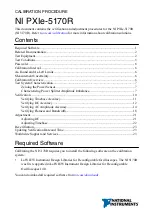
9.
Configure the power sensor to correct for the
Test Point Frequency
value using the power
sensor frequency correction function.
10. Use the power sensor to measure the power in dBm.
11. Repeat steps 8 through 10 for each configuration in the
Power Splitter Characterization
table, recording each result as
splitter output 2 power
, where each configuration has a
corresponding value.
12. Disconnect the power sensor and 50 Ω SMA terminator (f) from splitter output 2 and
splitter output 1.
13. Connect the power sensor to splitter output 1.
14. Connect the 50 Ω SMA terminator (f) to splitter output 2.
The following figure illustrates the hardware setup.
Figure 2.
Connection Diagram for Measuring at Splitter Output 1
1
6
5
4
5
3
7
8
2
1. Signal Generator
2. SMA (f)-to-N (m) Adapter
3. SMA (m)-to-SMA (m) Cable
4.
50 Ω
SMA Terminator (f)
5. SMA (m)-to-SMA (m) Adapter
6. Power Splitter
7. SMA (f)-to-N (f) Adapter
8. Power Sensor
15. Configure the signal generator to generate a sine waveform with the following
characteristics:
•
Frequency: the
Test Point Frequency
value from the
Power Splitter Characterization
table
•
Amplitude level: the
Test Point Amplitude
value from the
Power Splitter
Characterization
table
NI PXIe-5170R Calibration Procedure
|
© National Instruments
|
9










































